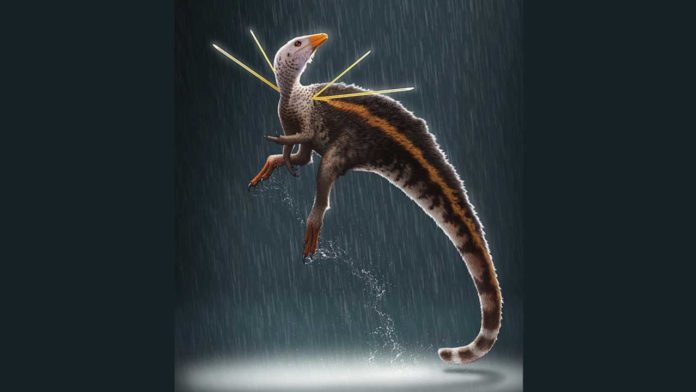Several of these dinosaurs are adorned with elaborate integumentary structures that have been linked to behaviors, including thermoregulation, egg incubation, and sexual display.
Recently, scientists from the University of Portsmouth found the most elaborately dressed-to-impress dinosaur named Ubirajara jubatus. This discovery sheds new light on how birds such as peacocks inherited their ability to show off.
The dinosaur was chicken-sized with a mane of long fur down its back and stiff ribbons projecting out and back from its shoulders. Scientists think that its features were used to dazzle mates or intimidate foes.
It lived about 110 million years ago, during the Aptian stage of the Cretaceous period. The long, thick mane running down the animal’s back might have been controlled by muscles allowing it to be raised.
When not in display mode, the animal could lower its mane close to the skin to move fast. Well, the mane isn’t the only extraordinary feature.
Its long, flat, stiff shoulder ribbons of keratin, each with a small sharp ridge running along the middle, also catch scientists’ attention. These ribbons were positioned to not impede freedom of movement in its arms and legs, so they wouldn’t have limited the animal’s ability to hunt, preen, and send signals.
Scientists discovered the fossils of Ubirajara jubatus while examining fossils in Karlsruhe’s collection.
Professor David Martill, lead author of the study, “What is especially unusual about the beast is the presence of two very long, probably stiff ribbons on either side of its shoulders that were probably used for display, for mate attraction, inter-male rivalry or to frighten off foe.”
“We cannot prove that the specimen is a male, but given the disparity between male and female birds, it appears likely the specimen was a male, and young, too, which is surprising given most complex display abilities are reserved for mature adult males.”
“Given its flamboyance, we can imagine that the dinosaur may have indulged in elaborate dancing to show off its display structures.”
Robert Smyth from the University of Portsmouth said, “These are such extravagant features for such a small animal and not at all what we would predict if we only had the skeleton preserved. Why adorn yourself in a way that makes you more obvious to both your prey and to potential predators?”
“The truth is that for many animals, evolutionary success is about more than just surviving; you also have to look good if you want to pass your genes on to the next generation.”
“Modern birds are famed for their elaborate plumage and displays that are used to attract mates – the peacock’s tail and male birds-of-paradise are textbook examples of this. Ubirajara shows us that this tendency to show off is not a uniquely avian characteristic, but something that birds inherited from their dinosaur ancestors.”
Mr. Smyth said, ‘Ubirajara is the most primitive known dinosaur to possess integumentary display structures. It represents a revolution in dinosaur communication, the effects of which we can still see today in living birds.”
Professor Frey excavated the specimen from the two slabs of stone. It lay and, using x-ray, found previously hidden skeletal elements and soft tissue, allowing the researchers to build a clear picture of its features.
Hector Rivera Sylva, from Museo del Desierto, Mexico, said, “The Ubirajara jubatus is not only important because of the integumentary structures present for the first time in a non-avian dinosaur, completely changing the way of seeing the behavior of certain dinosaurs. Rather, the scientific value transcends, forming a watershed, since it is the first evidence for this group in Latin America, as well as one of the few reported for the subcontinent of Gondwana, expanding the knowledge about non-avian feathered dinosaurs for America, whose evidence is very scarce.”
Journal Reference:
- Robert S.H.Smyth et al. A maned theropod dinosaur from Gondwana with elaborate integumentary structures. DOI: 10.1016/j.cretres.2020.104686
